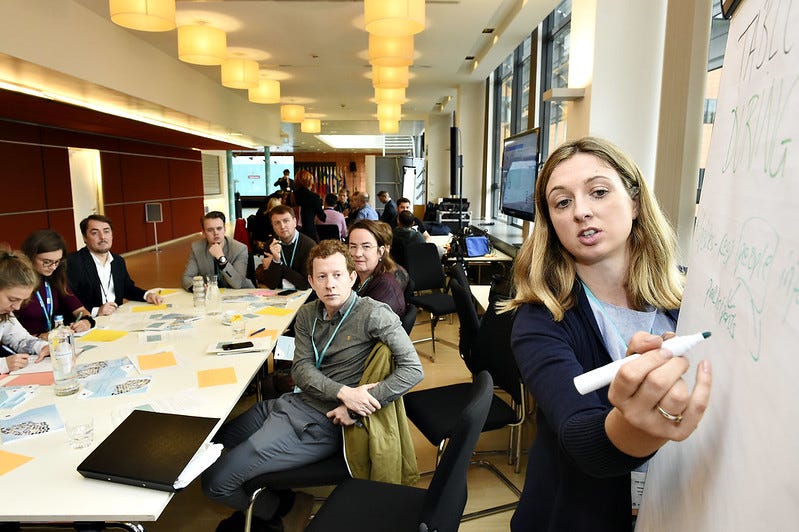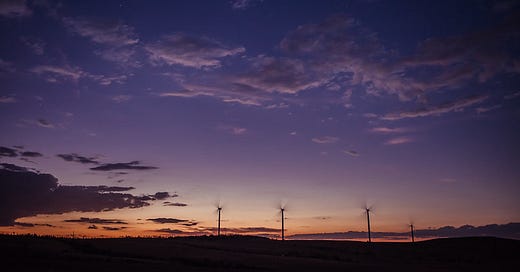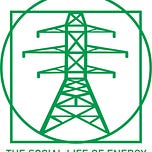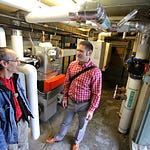“As a nimby, you start researching and thinking critically. They are pushing through their principles, without sufficiently taking into account the well-being of citizens and the natural environment.” – Amsterdam activist against turbines (Volkskrant newspaper).
“The men are suspected to send threatening letters to wind farm employees, creating a black paper with libellous texts and threatening to dump asbestos (which indeed occurred near wind turbine locations in 2018 and 2019.)” – Trouw newspaper report about a court case against two farmers.
Dear folks,
Welcome to the final instalment of my improvised triptych about what makes successful aeolian power generation possible. I dare say, the tableau is turning into a gripping picture of details and devils! Last issue it was all about giving energy communities the rights and financial wherewithal to become full members of Grid Nation. Today, it’s about how ‘communities’ participate in the siting of new wind turbines.
Judging by the two Dutch examples above, we apparently still haven’t figured out how to do this, despite having some 30 years of experience to build on. Why is that? What you’ll learn about it today:
In theory it’s simple: you need to notify people on time, supply adequate information, make sure that people can meaningfully contribute, and assign an independent party to manage the process.
Why? Because only due process can guarantee acceptable outcomes.
Legitimacy is therefore always a locally tailored product. You can’t manufacture it only through bureaucratic standards of “fairness”.
You therefore also need a versatile toolkit of participatory and deliberative decision-making that can adapt to local circumstances.
The promise of procedural justice
In 2007, Catherine Gross devised a “framework for procedural justice”, which went on to be cited nearly a 1000 times, according to Google Scholar (1000 times is a lot for the poor huddled citation-starved masses of social scientists). She starts with a simple observation: wind energy conflicts are complicated because they’re not of a clash of (clear-cut) interests, but the interplay of criss-crossing community relations. She then visits a recently completed wind farm in New South Wales to talk to people about how they felt the decision-making process went.

Overall, people didn’t think the NSW project did great.
Many people hadn’t felt heard, they had gotten the impression there was scheming going behind closed doors, and they worried about what it was doing to the community – that is, creating winners and losers. In other words, they worried about both the process and its outcomes.
Gross suggests that the worry over what it does to the community makes the fairness of the process all the more important, “because it is more likely to lead to a fair outcome, particularly when there is no clear standard as to exactly what a fair outcome is” (p. 2734, my emphasis). That last bit is important, we’ll get back to it towards the end.
Based on their review and suggestions, Gross came up with a straightforward set of guidelines about how to do things better.
Timely notification and inclusion of all concerned
Meaningful ability to participate and contribute to decision-making
Being heard on equal footing with other participants
Getting adequate information from impartial sources
Led by an independent facilitator
Receiving response to input
That… seems doable, doesn’t it? Let’s see how this compares to some real-life consultation processes.
The practice of distributive justice
Right around the same time Gross was jotting down these helpful notes, Denmark was seeing a decline in interest in, and growth in controversy over, wind development projects, after a decade or so of spectacular initial success. Commentators (such as Bauwens et al 2016, Mey and Diesendorf 2018, Roberts 2020) suggest that the change in fate followed a shift from community-driven to corporate-driven development. If so, the Danish government only treated the symptoms by stipulating standards of minimum fairness (through compensation, benefit-sharing or co-ownership).
In a recent article, Marie Leer Jorgenson and her colleagues reviewed two of these rules: one to compensate for the loss of property value, thus reducing the burden; a second to allow and require a minimum of surrounding residents to invest in the project through shares, thus sharing in the benefits. The rules defined how much compensation was available to whom and who would get (preferential) access to the shares.
In order to find out how these rules were working out for people, the researchers visited three different sites: three development initiated by one or multiple farmers, one project mostly owned by the farmers themselves, one at the behest of a Copenhagen based utility, and another sold to an external investor after set-up. Each approached participation and the execution of these mechanisms differently.
In the case of the latter two projects, focus groups and interviews suggested that most people did not think the compensation schemes were fair. They felt the burdens on those living nearest to the turbines was too big; that external investors were making profit (or cleaning their CO2 slate) over the backs of locals; that the (meagre) sums they received did not address the degradation in the quality of their environment; that buying shares as a tool disadvantages the poor. In the first case, where all the co-ownership shares were actually sold, residents were more positive, though some voiced similar objections.
Learning the wrong lessons?
Now, the Danish government created these laws because they wanted this great transition towards renewables to be fair. However, re-reading Gross and now reading Jorgenson et al, it seems like Danish lawmakers drew the wrong conclusions about how to make sure things are fair.
Remember Gross’ main conclusions: ‘fair procedure’ is the most important of all the justice principles. However, the Danish community provisions targeted distributive justice.
Deprioritizing fair procedures (and letting standard planning consultation practices do the work of gathering input) has two consequences.
One, it makes it more difficult to tailor to local problems and solutions. For instance, the law stipulates a 4,5 km radius in which people can apply for shares. In some cases that may make sense, but in others it doesn’t.
Two, and this is a closely related point, it makes it more difficult for people to feel they are heard and recognized for their specific values, hopes and fears. For instance, when people feel monetary compensation is inadequate and inappropriate for the loss of quality of life that they experience or fear. But there’s no room for that, because the bounds of discourse have already been set by the mechanism.
In that sense, the Danish compensation mechanisms are not merely insufficient, but even counterproductive.
Legitimate (accepted) wind development project needs to do justice to standards of fairness in all dimensions: in terms of outcome (distributive), participation (procedural) and recognition (for instance, of non-monetary value of the environment).

Beyond invited citizen consultation: here be unicorns
I can feel some despair creeping into the pit of your stomach. There’s too many variables! How can anyone do these justice?? Well, yes. But: there’s this slogan by the Dutch Tax Services, from the good ol’ days, when they could still claim to act in the public’s interest, “we can’t make it any more fun, but we can make it easier”. Well, I’m here to make a different promise: “we can’t make it any easier, but we can make it more exciting!”
For this promise, I’m turning to Helena Solman, PhD candidate at Wageningen University’s Environmental Policy Group (full Monty: I know Helena from the time I did my postdoc there). For an (open access) review that’s hot of the presses, she went through all the literature she could find looking for examples that offered a much wider window of opportunity to participate: different kinds of people, different stages of planning and development, and a more diverse set of questions that people got to tackle. This broader set of engagements she calls co-production.
We sat down for a Zoom session together. Here’s Helena explaining co-production:
What is often forgotten is the wind turbine technology itself. Usually, we often only discuss acceptable locations, and I think that the story can be much more nuanced in terms of how and when projects can be acceptable. Take concerns about birds and bird strikes. Should people say only yes or no to wind turbines, or could it be a conditional ‘Yes, if you improve this or that’?
So we can open up the discussion about what kind of wind turbines, how many, how tall are acceptable. And I think that there is a huge potential in making better use of digital technologies in the design phase, so, to have a better idea about how much noise they will be producing, how they will look in the landscapes, or who will have the negative impact of shadow flicker. So to make that much more tangible to people, and to try and experiment with the design, to see what is better, right? Is it a few smaller wind turbines, or one big one?
In other words: stop asking people whether they find something acceptable or not – y/n, location A or B, and sign on the dotted line – but give them responsibility in shaping the renewable landscape of the future. This is perhaps the most profound follow-up to Gross’ insight into the value of fair procedures: they are important because often we don’t know what the right outcome is.
Opening things up like that, though, is guaranteed to be messy, and requires adjustments from planners, developers, citizens and even turbine manufacturers – but it seems to me the payoff will be all the greater.
You can take advantage of Helena’s near-encyclopaedic knowledge of the topic by listening to our entire chat by clicking on the play button above, or by tuning in through your favourite podcast app. We jointly reviewed the points of this newsletter, so it’s a nice added layer. If you don’t want to listen, you can read extensive excerpts from the transcript here.
For now I bid thee adieu with our last piece of sonic fabric to tie up this triptych. It all started with the Texan corridos offshoot of mariachi, with a story about life across borders, we then had the back-to-the-roots mariachi from last week, and now, to close off somewhat in style, we’re crossing two more borders and multiple music genres: a collab from the ill-fated band Armistice – victim to the vagaries of romantic love – and Mariachi el-Bronx. Enjoy and till next time!
Marten
Sources
Gross, Catherine. 2007. "Community perspectives of wind energy in Australia: The application of a justice and community fairness framework to increase social acceptance". Energy Policy. 35 (5): 2727-2736. https://doi.org/10.1016/j.enpol.2006.12.013
Solman, Helena, Mattijs Smits, van, Bas Vliet, and Simon Bush. 2021. "Co-production in the wind energy sector : A systematic literature review of public engagement beyond invited stakeholder participation". Energy Research & Social Science. 72. https://www.sciencedirect.com/science/article/pii/S2214629620304515
Leer Jørgensen, Marie, Helle Tegner Anker, and Jesper Lassen. 2020. "Distributive fairness and local acceptance of wind turbines: The role of compensation schemes". Energy Policy. 138. https://doi.org/10.1016/j.enpol.2020.111294














Share this post